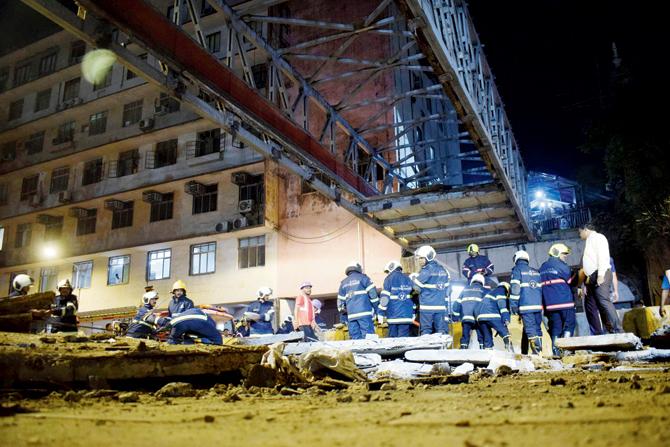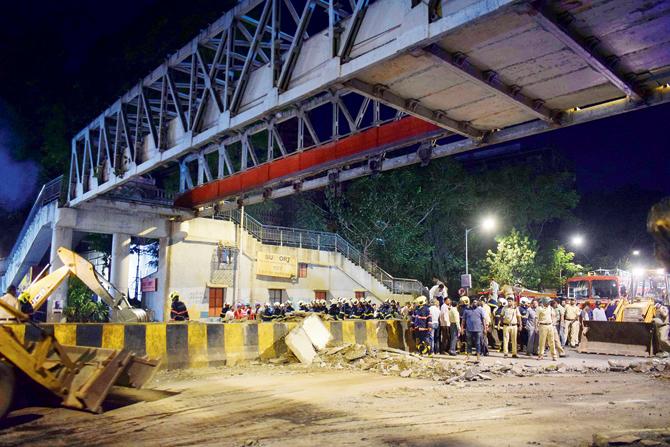BMC's inquiry, which is at its initial stage, into last Thursday's CSMT bridge collapse, points to a possible welding fault under the FOB's floor

Initial inquiry has pointed to possible glitches in the welding of the iron rods at the base of the bridge as the reason for its collapse
A welding failure seems to be one of the causes behind Thursday's CSMT bridge collapse. With the onset of a detailed inquiry into the incident that killed six and injured 31, officials are suspecting that a glitch in the welding of iron rods below the flooring might have caused the crash. The structural auditor might have failed to inspect the base of the FOB's flooring, civic officials believe.
ADVERTISEMENT

The bridge collapsed on Thursday killing six people and injuring 31
Also Read: These railway bridges in Mumbai are declared dangerous, but still standing
A preliminary inquiry report issued by civic chief Ajoy Mehta on Friday had held Professor DD Desai's Associated Engineering Consultants responsible for carrying out the structural audit in "an irresponsible and negligent manner" and RPS Infrastructure for carrying out repairs that weren't "up to the mark". The inquiry also placed the blame on three junior engineers, a retired deputy chief engineer and a retired chief engineer on the BMC. While two engineers have been suspended, three other civic officials will face a full-fledged departmental inquiry.
The contractor who worked on the bridge in 2016, for its beautification, has been excluded from the preliminary investigation but will be probed during the detailed inquiry, said civic officials.

The CSMT bridge was around 30 years old and had been beautified two years ago
Structural repairs on the more than 30-year-old CSMT bridge were carried out in 2013 but that did not involve any work on the base. The next work on the bridge was directly undertaken in 2016 during its beautification. Around the same time, Professor DD Desai's Associated Engineering Consultants was appointed to examine the bridge. The firm, however, only conducted a preliminary inspection of it and the non-destructive tests to identify its structural stability were carried out only in 2017 after the beautification work was completed. The report submitted by the auditor had stated that the bridge was in a "good condition" without mentioning corrosion on its sides.
With the entire bridge now being dismantled, the BMC will carry out a structural check of its debris (in police custody) through forensic testing, said a senior civic official.
The BMC has expressed its dissatisfaction over the 2017 audit that grossly neglected the welding work at the base. "There is a possibility that the auditors have not checked the base of the steel structure where we suspect the problem might have lied. The tests were not carried out properly and the condition was stated to be good which directly points to the auditor's mistake along with the bridge department staff," a senior civic official said.
Also Read: CST bridge collapse: Cops to build 15-member team for case against MCGM officials
Oppn questions re-audit
The BMC is likely to invite short-term tenders for another auditor to re-audit 38 bridges in the city that were earlier audited by Professor DD Desai's Associated Engineering Consultants. BMC chief Mehta has also asked structural auditors of the eastern and western suburbs' bridges (over 200) to begin re-auditing their work and submit fresh reports within a month. Opposition party members in the BMC have, however, raised questions over the re-auditing by the same auditors.
Catch up on all the latest Mumbai news, crime news, current affairs, and also a complete guide on Mumbai from food to things to do and events across the city here. Also download the new mid-day Android and iOS apps to get latest updates
 Subscribe today by clicking the link and stay updated with the latest news!" Click here!
Subscribe today by clicking the link and stay updated with the latest news!" Click here!






